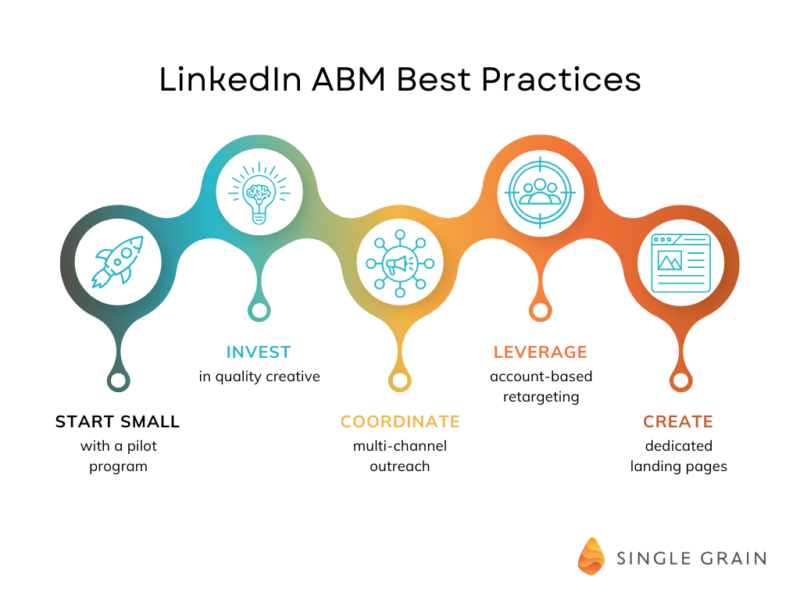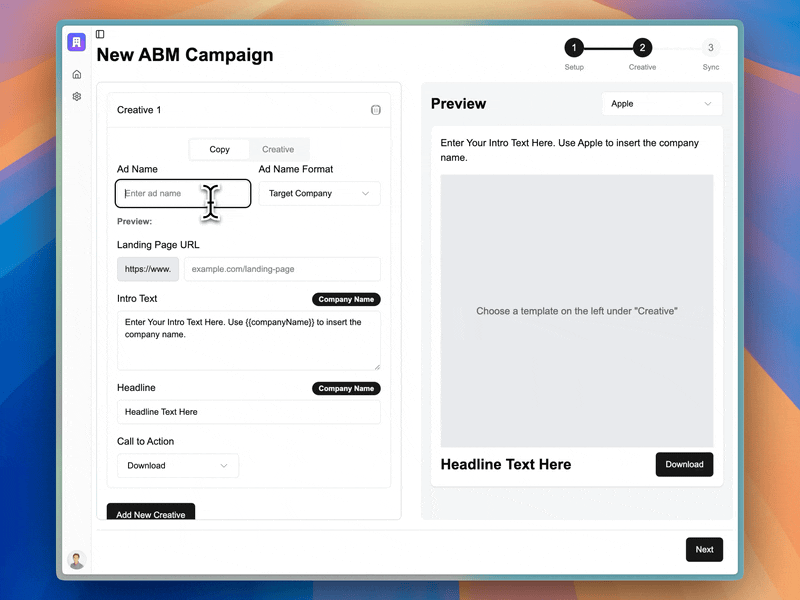Launching an effective Account-Based Marketing (ABM) campaign on LinkedIn requires strategic planning and precise execution. Many B2B marketers struggle to convert high-value leads, but with the right approach, you can target decision-makers at your ideal accounts with personalized messaging that resonates.
In today’s competitive B2B landscape, generic marketing approaches simply don’t cut it anymore. LinkedIn ABM campaigns allow you to focus your resources on the accounts most likely to convert, creating tailored experiences that speak directly to their specific needs and challenges.
Key Highlights
- 208% revenue increase is possible with a well-executed ABM strategy, making it one of the most effective approaches for B2B companies
- 97% of marketers report that ABM delivers a higher return on investment than other marketing strategies
- Creating an ideal customer profile (ICP) is the critical first step in any successful LinkedIn ABM campaign
- Cross-functional team alignment between sales and marketing departments increases your chances of exceeding revenue goals by 6%
- Only 36% of companies executing ABM programs consider their sales and marketing teams tightly aligned, creating an opportunity for competitive advantage
- Personalized LinkedIn ads can achieve up to 3x higher engagement rates compared to generic ads
- AI-powered personalization tools like Karrot.ai can improve conversion rates by up to 70% for 1-1 personalized LinkedIn ads
- Post-campaign optimization of LinkedIn ABM efforts can improve performance by 30% in subsequent campaigns
TABLE OF CONTENTS:
Understanding LinkedIn ABM Fundamentals
Account-based marketing on LinkedIn isn’t just another marketing tactic—it’s a comprehensive strategy that aligns your sales and marketing efforts to target high-value accounts. According to recent data, 70% of marketers now have an active ABM program in place, with companies dedicating an average of 29% of their marketing budget to these initiatives.
LinkedIn stands out as the premier platform for B2B ABM campaigns due to its professional user base and robust targeting capabilities. The platform’s business-focused environment makes it ideal for reaching decision-makers and influencers within your target accounts.
Why LinkedIn Excels for ABM
LinkedIn provides unparalleled access to professional data that enables precise targeting. With over 900 million professionals on the platform, including 63 million decision-makers, LinkedIn offers the most comprehensive B2B targeting capabilities available.
The platform’s targeting options allow you to zero in on specific companies, job titles, industries, and even skills—making it possible to create highly personalized campaigns that speak directly to your ideal customer profile. This level of precision is why LinkedIn account-based marketing is particularly effective for attracting qualified leads compared to other platforms.
Step 1: Define Your Target Accounts and ICP
The foundation of any successful LinkedIn ABM campaign is identifying the right accounts to target. While ABM boasts a 208% increase in business revenue, you won’t see those results if you don’t know your target companies.
Creating Your Ideal Customer Profile
Start by analyzing your current customer base to identify common characteristics among your most valuable clients. Consider factors such as:
- Industry and company size
- Annual revenue and growth rate
- Geographic location
- Technology stack and tools used
- Business challenges and pain points
- Decision-making structure
Organizations with a strong Ideal Customer Profile (ICP) achieve 68% higher account win rates, making this step crucial to your campaign’s success.
Building Your Target Account List
Once you’ve defined your ICP, it’s time to build your target account list. LinkedIn’s Sales Navigator is an invaluable tool for this process, allowing you to search for companies that match your criteria and save them to targeted lists.
Research shows that 57% of ABM marketers target 1,000 accounts or fewer, with 38% being the average number of accounts organizations pursue at one time. Starting with a focused list allows you to dedicate sufficient resources to each account and create truly personalized experiences.
Step 2: Assemble Your Cross-Functional ABM Team
ABM success depends on close collaboration between various departments, particularly sales and marketing. Create a cross-functional team where these teams can collaborate on a single strategy.
Here’s what an effective LinkedIn ABM team structure looks like:
| Team Member | Primary Responsibilities | Key Skills Needed |
|---|---|---|
| ABM Manager | Strategy oversight, team coordination | Project management, strategic thinking |
| Marketing Specialists | Content creation, campaign execution | LinkedIn ad platform expertise, content creation |
| Sales Representatives | Account engagement, relationship building | Relationship management, industry knowledge |
| Data Analysts | Performance tracking, insights generation | Analytics, data interpretation |
| Creative Team | Ad design, landing page creation | Visual design, copywriting |
Only 36% of companies executing ABM programs consider their sales and marketing teams tightly aligned, yet this alignment can make you 6% more likely to exceed your revenue goals. Prioritizing team coordination creates a significant competitive advantage.
Step 3: Develop Deep Account Insights
Understanding your target accounts is critical for effective ABM. Conduct in-depth research to uncover key details about each account, including:
- Recent company news and developments
- Business challenges and growth initiatives
- Competitive landscape
- Decision-makers and their professional backgrounds
- Content engagement patterns
LinkedIn provides valuable intelligence through company pages, employee profiles, and published content. Pay attention to what your target accounts are posting, sharing, and engaging with to understand their priorities and pain points.
Step 4: Create Your LinkedIn ABM Campaign Strategy
With your accounts identified and research complete, it’s time to develop your campaign strategy. This should include:
Content Mapping for the Buyer’s Journey
Different stakeholders within your target accounts will have different concerns and information needs. Create content that addresses each stage of the buyer’s journey:
- Awareness: Educational content that highlights industry challenges
- Consideration: Solution-focused content that demonstrates your understanding of their specific needs
- Decision: Case studies, ROI calculators, and comparison guides
Research shows that 61% of marketers tailor content to specific industries, making this personalization a standard practice for competitive ABM campaigns.
LinkedIn Campaign Types for ABM
LinkedIn offers several ad formats that work well for ABM campaigns:
- Sponsored Content: Share valuable content directly in the LinkedIn feed
- Message Ads: Deliver personalized messages to decision-makers’ inboxes
- Dynamic Ads: Automatically personalize ad creative with the recipient’s profile information
- Conversation Ads: Create interactive, choose-your-own-path experiences
Personalized LinkedIn ads can achieve up to 3x higher engagement rates compared to generic ads, making customization essential for campaign success.
Step 5: Implement Personalization at Scale
Personalization is the cornerstone of effective ABM, but scaling personalization across multiple accounts can be challenging. This is where technology solutions become essential.
Leveraging AI for Personalization
AI-powered tools like Karrot.ai can transform the effort involved in creating personalized ads at scale. These platforms allow you to:
- Automatically generate personalized ad creative for each target account
- Customize messaging based on industry, role, and pain points
- Test multiple variations to identify the most effective approaches
- Maintain brand consistency while delivering personalized experiences
Companies implementing 1-1 personalized LinkedIn ads with tools like Karrot.ai report conversion rate improvements of up to 70% compared to generic campaigns. This dramatic improvement stems from the ability to speak directly to each account’s specific situation and challenges.
Step 6: Launch and Monitor Your Campaign
With your strategy defined and assets created, it’s time to launch your LinkedIn ABM campaign. Proper setup includes:
- Creating saved audiences in LinkedIn Campaign Manager for your target accounts
- Setting appropriate campaign objectives aligned with your goals
- Establishing budget allocations and bid strategies
- Implementing tracking parameters for accurate measurement
Key Metrics to Track
Measuring the effectiveness of ABM programs is a challenge for 42% of businesses. Focus on these key metrics:
- Account engagement rate
- Content engagement by decision-makers
- Website visits from target accounts
- Meeting requests and conversions
- Pipeline contribution and velocity
- Closed deals and revenue impact
Using LinkedIn’s built-in analytics alongside your CRM system provides a comprehensive view of campaign performance and account engagement.
Step 7: Optimize and Iterate
ABM is not a “set it and forget it” strategy. Continuous optimization is essential for maximizing results.
Post-campaign optimization of LinkedIn ABM efforts can improve performance by 30% in subsequent campaigns. Regular analysis allows you to:
- Identify which messages and content types resonate most with different accounts
- Refine targeting parameters based on engagement patterns
- Adjust budget allocation to focus on the most responsive accounts
- Test new creative approaches and value propositions
Best Practices for LinkedIn ABM Success

To maximize the effectiveness of your LinkedIn ABM campaigns, follow these proven best practices:
- Start small with a pilot program targeting your highest-value accounts before scaling
- Invest in quality creative that stands out in the LinkedIn feed
- Coordinate multi-channel outreach by complementing LinkedIn ads with email, direct mail, and sales outreach
- Leverage account-based retargeting to maintain visibility throughout the buying process
- Create dedicated landing pages for target accounts that speak directly to their needs
Conclusion
Implementing a successful LinkedIn ABM campaign requires careful planning, cross-functional collaboration, and strategic execution. By following the steps outlined in this guide, you can create highly targeted campaigns that resonate with your ideal accounts and drive measurable business results.
With 97% of marketers reporting that ABM delivers a higher ROI than other marketing strategies, the investment in a well-structured LinkedIn ABM program is well worth the effort. The key is to maintain a laser focus on your target accounts and continuously refine your approach based on performance data.
As you implement these strategies for your LinkedIn ABM campaigns, consider how automation tools like Karrot.ai can help you scale personalization without sacrificing quality or increasing workload. The ability to create personalized experiences for each target account is what ultimately sets successful ABM campaigns apart from traditional marketing approaches.




